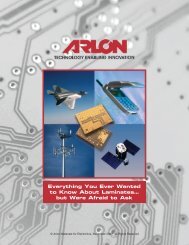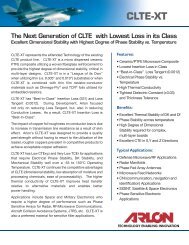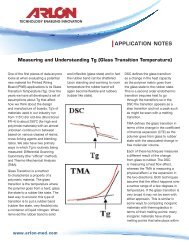Thermal Management Solutions for Electronics - Arlon MED
Thermal Management Solutions for Electronics - Arlon MED
Thermal Management Solutions for Electronics - Arlon MED
You also want an ePaper? Increase the reach of your titles
YUMPU automatically turns print PDFs into web optimized ePapers that Google loves.
3<br />
Understanding Heat Transfer<br />
Heat is generated every time an active device is in operation. Device operating temperature is a result<br />
of the balance between heat generation and heat dissipation. Heat itself does not become a problem<br />
until there is enough heat to result in an increase in temperature above a critical point, in many cases<br />
about 105 to 120°F. Since many designs are set based on function, the heat generation side of the<br />
equation is already determined by the time it comes to managing heat dissipation. As such, it is<br />
important to understand the basics of heat transfer to determine possible strategies <strong>for</strong> reducing<br />
device temperature. In simple terms, the whole business of managing heat in a PWB assembly is<br />
about preventing the junction temperature from getting high enough to “fry” the active devices.<br />
Heat is moved from a “hot” body to a cooler body by one of three basic modes: conduction,<br />
convection or radiation. In a PWB assembly, all three are in play to one degree or another.<br />
Conduction can be the most effective <strong>for</strong> heat transfer, where the cooler body is in direct (and<br />
preferably intimate) contact with the warmer one and the heat moves from hot to cold materials in an<br />
attempt to reach equilibrium. The rate at which heat is carried from one to the other depends on the<br />
thermal (temperature) gradient, the coefficient of heat transfer of materials involved (thermal<br />
conductivity), the amount of material involved in the thermal path (thickness), the quality of the<br />
interface and to a lesser extent, the heat capacity of the “cool body” that is absorbing the heat. The<br />
combined effects of thermal conductivity, the material thickness in the thermal path and the interface<br />
effects on heat flow is often characterized in terms of the thermal impedance.<br />
Convection is the transfer of heat from a hot body to a cooler fluid which carries it away through<br />
molecular motion. This can happen naturally in a fluid based on resulting density gradients caused<br />
by temperature variation. Convection may be aided by <strong>for</strong>cing the cooling fluid to flow past the warm<br />
body, thus carrying away the heat faster. Conversely, convection heat transfer can be significantly<br />
impeded by device enclosures that restrict air flow, resulting in higher device temperatures.<br />
Radiation is the removal of heat from a body by the emission of energy in the <strong>for</strong>m of<br />
electromagnetic radiation, which may be in the infrared (heat) or even visible (light) parts of the<br />
spectrum depending on the temperature of the radiating body. RF signals, such as those generated<br />
by an antenna, are also a type of radiation that dissipates energy.<br />
Heat Transfer Models





